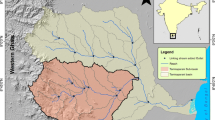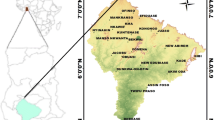Abstract
Estimation of spatial extent of soil erosion, one of the most serious forms of land degradation, is critical because soil erosion has serious implications on soil fertility, water ecosystem, crop productivity and landscape beauty. The primary objective of the current study was to assess and map the soil erosion intensity and sedimentation yield of Potohar region of Pakistan. Potohar is the rainfed region with truncated and complex topography lying at the top of the Indus Basin, the world’s largest irrigation networks of canals and barrages. Spatially explicit Revised Universal Soil Loss Equation (RUSLE) Model integrated with Remote Sensing-GIS techniques was used for detecting/mapping of erosion prone areas and quantification of soil losses. The results show that the Potohar region is highly susceptible to soil erosion with an average annual soil loss of 19 tons ha−1 year−1 of which the maximum erosion (70–208 tons ha−1 year−1) was near the river channels and hilly areas. The sediment yield due to the erosion is as high as 148 tons ha−1 year−1 with an average of 4.3 tons ha−1 year−1. It was found that 2.06% of the total area falls under severe soil erosion, 13.34% under high erosion, 15.35% under moderate soil erosion while 69.25% of the area lies in the low (tolerable) soil erosion. Chakwal and Jhelum districts of the region are seriously affected by erosion owing to their topography and soil properties. The information generated in this study is a step forward towards proper planning and implementation of strategies to control the erosion and for protection of natural resources. It is, hence, necessary that suitable water harvesting structures be made to control water to prevent soil erosion and provision of water in the lean season in this region. Tree plantation and other erosion control practices such as strip cropping can also minimize soil erosion in this region.








Similar content being viewed by others
References
Abdo H, Salloum J (2017) Mapping the soil loss in Marqya basin: Syria using RUSLE model in GIS and RS techniques. Environ Earth Sci 76:114
Ahmad S, Khan M, Ikram MA (1990) Soil and water conservation and integrated land use in Pothwar, Pakistan. In: Soil physics: applications under stress environments. Pakistan Agriculture Research Council, Islamabad, pp 301–312
Ananda J, Herath G (2003) Soil erosion in developing countries: a socio-economic appraisal. J Environ Manage 68:343–353
Andriyanto C, Sudarto S, Suprayogo D (2015) Estimation of soil erosion for a sustainable land use planning: RUSLE model validation by remote sensing data utilization in the Kalikonto watershed. J Degrad Min Lands Manag 3(1):459–468
Anjum SA, Wang L, Xue L, Saleem MF, Wang G, Zou C (2010) Desertification in Pakistan: causes, impacts and management. J Food Agric Environ 8:1203–1208
Anton JJ, Rompaey V, Bazzoffi P, Robert JJ, Montanarella L, Govers G (2003) Validation of soil erosion risk assessments in Italy. European Soil Bureau Research Report No.12, EUR 20676 EN. Office for Official Publications of the European Communities, Luxembourg
Ashraf M, Khan M (2000) Sustainable environment management: impact of agriculture. Sci Techol Dev 19:51–57
Ashraf M, Hassan F, Saleem A, Iqbal M (2002) Soil conservation and management: a prerequisite for sustainable agriculture in Pothwar. Sci Techol Dev 21:25–31
Baig M, Zia M, Tahir M (1999) Soil environmental issues and their impact on agricultural productivity of low potential areas of Pakistan. Science Vision 4:56–60
Bashir S, Baig M, Ashraf M, Anwar M, Bhalli M, Munawar S (2013) Risk assessment of soil erosion in Rawal watershed using Geoinformatics Techniques. Sci Int 25:583–588
Bathrellos GD, Gaki-Papanastassiou K, Skilodimou HD, Papanastassiou D, Chousianitis KG (2012) Potential suitability for urban planning and industry development by using natural hazard maps and geological-geomorphological parameters. Environ Earth Sci 66(2):537–548
Bathrellos GD, Skilodimou HD, Chousianitis K, Youssef AM, Pradhan B (2017) Suitability estimation for urban development using multi-hazard assessment map. Sci Total Environ 575:119–134
Beskow S, Mello CR, Norton LD, Curi N, Viola MR, Avanzi JC (2009) Soil erosion prediction in the Grande River Basin, Brazil using distributed modeling. Catena 79:49–59
Cheema MJM, Bastiaanssen WGM (2012) Local calibration of remotely sensed rainfall from the TRMM satellite for different periods and spatial scales in the Indus Basin. Int J Remote Sens 33:2603–2627
Djoukbala O, Mazour M, Hasbaia M, Benselama O (2018) Estimating of water erosion in semiarid regions using RUSLE equation under GIS environment. Environ Earth Sci 77:345
Farhan Y, Nawaiseh S (2015) Spatial assessment of soil erosion risk using RUSLE and GIS techniques. Environ Earth Sci (2015) 74:4649–4669
Farooq U, Munir A, Jasra AW (2007) Natural Resource Conservation, Poverty Alleviation and Farmer Partnership. The Pakistan Development Review.46:4 Part II (Winter 2007), pp. 1023
Flanagan D, Nearing M (1995) USDA-water erosion prediction project: hillslope profile and watershed model documentation. NSERL Report #10. USDA-ARS National Soil Erosion Research Laboratory, West Lafayette, Indiana, p 298
Gassman PW, Arnold JJ, Srinivasan R, Reyes M (2010) The worldwide use of the SWAT model: technological drivers, networking impacts, and simulation trends. In Proc. 21st century watershed technology: improving water quality and environment, ASABE 21–24 February 2010, Universidad EARTH, Costa Rica. ASABE, St. Joseph, MI
Ghani MW, Arshad M, Abdul S, Aamir S, Nasir M, Ijaz A (2013) Investigation of potential water harvesting sites at Potohar using modeling approach. Pak J Agr Sci 50:723–729
Hudson N (1981) Soil conservation, 2nd edn. Cornell University Press, New York
Irshad M, Inoue M, Ashraf M, Delower HKM, Tsunekawa A (2007) Land desertification: an emerging threat to environment and food security of Pakistan. J Appl Sci 7:1199–1205
Isaaks EH, Srivastava RM (1989) An introduction to applied geostatistics. Oxford University Press, New York, 500 pp
Jamal T, Naseer S, Hassan SS, Batool H, Mahmood R, Naz A, Butt A, Tanver U, Kaukab IS, Alvi S, Ahmad J (2018) Appraisal of deforestation in murree through open source satellite imagery. Adv Remote Sen 7:61–70
Jetten V (2002) LISEM user manual, version 2. x. Draft version January 2002. Utrecht Centre for Environment and Landscape Dynamics, Utrecht University, The Netherlands. pp 48
Jie C, Jing-Zhang C, Man-Zhi T, Zi-tong G (2002) Soil degradation: a global problem endangering sustainable development. J Geogr Sci 12:243–252
Jones DS, Kowalski DG, Shaw RB (1996) Calculating revised universal soil loss equation (RUSLE) estimates on department of defense lands: a review of RUSLE factors and US army land condition-trend analysis (LCTA) data gaps. Center for Ecological Management of Military Lands, Colorado State University, Fort Collins, Colorado, p 9
Julien PY (2010) Erosion and sedimentation, 2nd edn. Cambridge University Press, Cambridge, p 1139486969 (ISBN-10)
Khan M, Munir A, Hashmi H (2012) Review of available knowledge on land degradation in Pakistan. OASIS Country Report 3. ICARDA. https://apps.icarda.org/wsInternet/wsInternet.asmx/DownloadFileToLocal?filePath=Working_Paper_Series/OASIS/OASIS_3_Pakistan.pdf&fileName=OASIS_3_Pakistan.pdf Accessed 22 Feb 2016
Lal R (2003) Soil erosion and the global carbon budget. Environ Int 29:437–450
Millward AA, Mersey JE (1999) Adapting the RUSLE to model soil erosion potential in a mountainous tropical watershed. Catena 38:109–129
Morgan RPC, Davidson DA (1991) Soil erosion and conservation. Longman Group, U.K, London
Naipal V, Reick CH, Pongratz J, Van Oost K (2015) Improving the global applicability of the RUSLE model-adjustment of the topographical and rainfall erosivity factors. Geosci Model Dev 8:2893–2913
Nasir A, Uchida K, Ashraf M (2006) Estimation of soil erosion by using RUSLE and GIS for small mountainous watersheds in Pakistan. Pak J Water Resour 10:11–21
Organization for Economic Co-operation and Development (OECD) (2001) environmental indicators for agriculture: methods and results, vol 3. OECD, Paris
Oweis T, Ashraf M (eds) (2012) assessment and options for improved productivity and sustainability of natural resources in Dhrabi Watershed Pakistan. ICARDA, Aleppo, Syria. xviii + pp 205
Rao Y (1981) Evaluation of cropping management factor in Universal Soil Loss Equation under natural rainfall conditions of Kharagpur, India. In: Proceedings of the South-East Asian Regional symposium on problems of soil erosion and sedimentation, Asian Institute of Technology Thailand, p. 241–254
Renard KG, Foster GR, Weesies GR, McCool DK, Yoder DC (1997) Predicting soil erosion by water: a guide to conservation planning with the revised universal soil loss equation (RUSLE). US Department of Agriculture, Agricultural Handbook No 703. U.S. Government Printing Office, Washington, DC, USA
Roose E (1996) Land husbandry: components and strategy. FAO Soils Bull 70
Shah Z, Arshad M (2006) Land degradation in Pakistan: a serious threat to environments and economic sustainability. ECO Services International. http://www.eco-web.com/edi/index.htm
Stanchi S, Falsone G, Bonifacio E (2015) Soil aggregation, erodibility, and erosion rates in mountain soils (NW Alps, Italy). Solid Earth 6:403–414
Stewart B, Woolhiser D, Wischmeier J, Caro JH, Frere M (1975) Control of pollution from cropland. US EPA Report No 600/2-75-026 USDA Washington, DC
USDA (1978) Predicting rainfall erosion losses. A Guide to Conservation Planning. Washington DC
Wang G, Gertner G, Fang S, Anderson AB (2003) Mapping multiple variables for predicting soil loss by geostatistical methods with TM images and a slope map. Photogramm Eng Rem S 69:889–898
Weng TK, Mokhtar M (2004) Integrated water Resource Management of Pahang River Basin, 25 Malaysia: a study on initiatives to strengthen the institutional framework, institute for environment and development. Universiti Kebangsaan Malaysia
Wischmeier WH, Smith DD (1978) Predicting rainfall erosion losses-a guide to conservation planning. Agriculture Handbook No 537. US Department of Agriculture Science and Education Administration, Washington, DC, USA, p 168
Author information
Authors and Affiliations
Corresponding author
Rights and permissions
About this article
Cite this article
Ullah, S., Ali, A., Iqbal, M. et al. Geospatial assessment of soil erosion intensity and sediment yield: a case study of Potohar Region, Pakistan. Environ Earth Sci 77, 705 (2018). https://doi.org/10.1007/s12665-018-7867-7
Received:
Accepted:
Published:
DOI: https://doi.org/10.1007/s12665-018-7867-7




